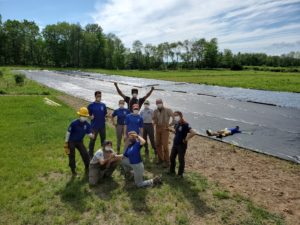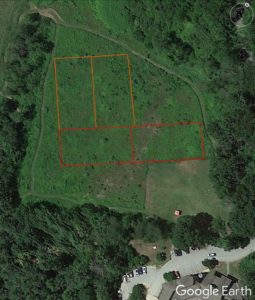Implementing a Landscape-Level Habitat Restoration Project
(photos and story by Marc Nutter)
“I finally did something that can be seen from space!” I told my mom and whoever else I talked to for the first few weeks of June this summer. This resulted in a lot of eye rolls, but most turned into interest in hearing more. We had just smothered ½ an acre of old field with landscaping fabric and black plastic and from Google Earth, it looks like it will be visible the next time our imagery gets updated.

Funded by the State Conservation Commission’s Moose Plate Grant Program, “Non-herbicidal Methods to Establish a Demonstration Pollinator Meadow” is a two year project led by Diane De Luca, Phil Brown, and me, Marc Nutter that will establish one acre of native pollinator meadow habitat next to our state headquarters in Concord on adjacent St. Paul’s School property.
Establishing a meadow from seed is all about the prep work, which got started in April with the removal of all the woody invasive shrubs by a mechanical shrub-shredder known in the industry as a Rayco Mower. The next step was to focus on the first half-acre (in red on the map below). Part of what we are doing is a landscape-level experiment to figure out what preparations methods work best at this scale. We mowed ¼ of an acre close to the ground and ¼ of an acre was completely tilled. Machines mostly did that part, so what came next was the real hard work.
With two waves of volunteers, we really got our hands dirty. In celebration of Earth Day in April, a crew of UNH Law students came and helped clean up all the debris left by Rayco work – this was a lot of raking and hauling away sticks, rocks, and any remaining vegetation. Next, on June 4, a crew from the Student Conservation Association was on site for an entire day to clean up after the mowing and tilling, and then covered the half acre with our two treatment methods: landscaping fabric and black plastic. This project would not have been able to get started without the hard work of all the individuals in these groups – thank you!
We look forward to seeding these first two plots and re-setting the tarps to the next two plots in October. We are also preparing for a workshop that will allow landowners to learn from our experience if they want to do something similar on their property.
If you are interested in learning more about this project or lending a hand in the next volunteer effort, please contact Marc Nutter at mnutter@nhaudubon.org.

